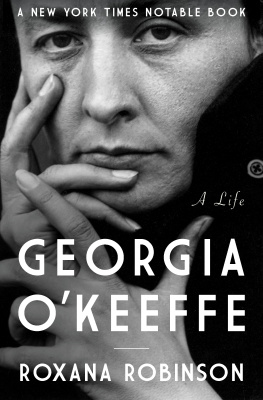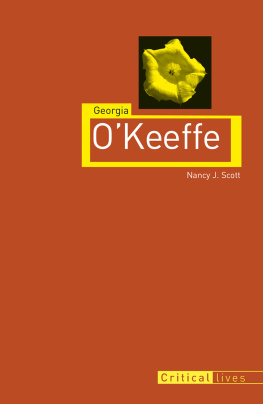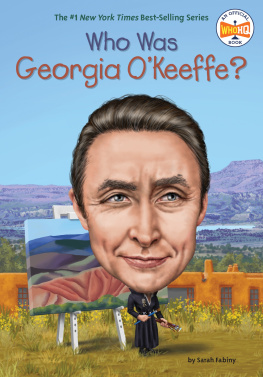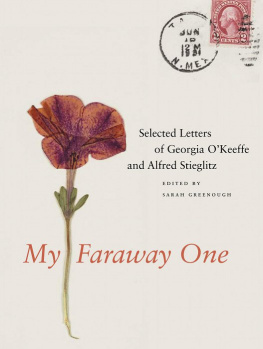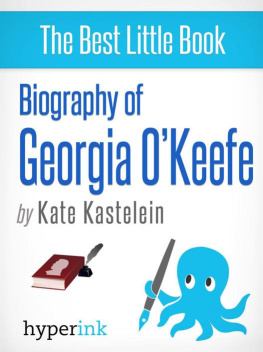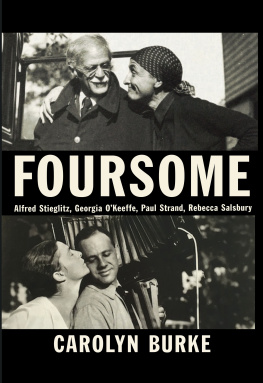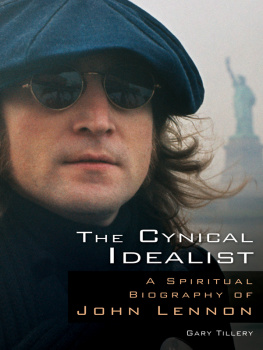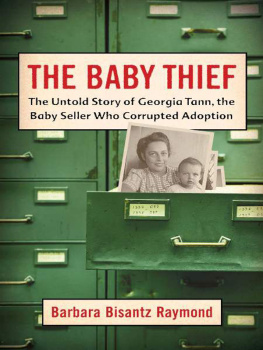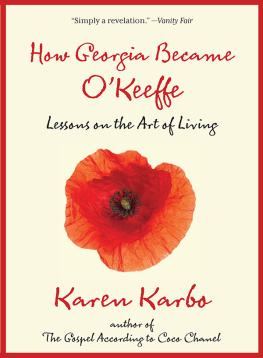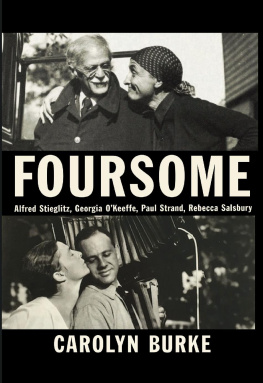Georgia OKeeffe
A Life
Roxana Robinson

This book about a daughter
is for
my own beloved and most wonderful daughter,
Roxana Scoville Alger
ACKNOWLEDGMENTS
Many of the people whom I interviewed gave their time and energy to a stranger, often welcoming me into their houses, offering me hospitality as well as attention. People I wrote and phoned were helpful and cooperative, often beyond my expectations.
For their generous assistance and their contributions of time, attention, and material, I would like to thank the following people and institutions: Ansel Adams Publishing Rights Trust; Perry Miller Adato, Channel 13; archivist, Amarillo News-Globe library; staff, Archives of American Art, New York; Art Institute of Chicago; Joan Baker, Santa Fe; Lorraine Baratti, library of Whitney Museum of American Art, New York; Peter Bunnell, Princeton University; Dan Budnik, Tucson; Roger Burlingame; John Cassel, Albuquerque; Maria Chabot, Albuquerque; Joe Chase, Sun Prairie Historical Society; Myrtle Cushing, Sauk City Historical Society; Donald Deskey; Terry Dintenfass; Cleta Downey; Richard Eldridge; Estate of Georgia OKeeffe; Tish Frank, Santa Fe; Mrs. Melinda Fryerson, Albemarle County Historical Society, Charlottesville.
Connell B. Gallagher, Bailey-Howe Memorial Library, University of Vermont; Donald Gallup of the Stieglitz Archive, Beinecke Rare Book and Manuscript Library, Yale University; Rufus Gaut, Amarillo Historical Society; Eugenie Gavenchak; Sarah Greenough, National Gallery of Art, Washington; Diana Haskell, Newberry Library, Chicago; Barbara Haskell, Whitney Museum of American Art, New York; Rose Hass, Tenth Avenue Editions; Diana Schubart Heller; Allan Hines; Frances Hallam Hurt, Chatham; David Johnston, Philadelphia Inquirer; Robert Kadlec; Jonathan Kelly; Jean A. Kenamore, Art Institute of Chicago; Margaret Kiskadden; the Klein family, Sun Prairie; Al Koschka, Amarillo Art Center; Sue Davidson Lowe; David McIntosh, Santa Fe; Wendy Maclaurin; Alan Macmahon; Louise March; Father Vidal Martinez, San Juan Pueblo; Herbert Miltzlaff, Clearwater, Florida; Anthony Montoya, Paul Strand Archives; Sarah Moody, Santa Fe; Beaumont Newhall; Jerrie Newsom; Dr. Michael Novacek, Department of Paleontology, American Museum of Natural History, New York; Alice Overbey, Chatham Historical Society; Morning Pastorok; Sarah Whitaker Peters; staff, Plains-Canyon Historical Society.
Dr. William Pollitzer; Aline and Eliot Porter; Mary Torr Rehm; Virginia Robertson; Amy Rule and staff, Photographic Archives, Center for Creative Photography, University of Arizona, Tucson; Keith Sandburg; Susan Loeb Sandburg; Cristina Sebring; Sandy Seth, Taos; John W. Smith; William Stapp, National Portrait Gallery; Mrs. Richard Stegall, Kappa Delta Society; Frances Steloff, Gotham Book Mart, New York; Diana Stoll, Artforum; Flora Stieglitz Straus; Geraldine Strey, State Historical Society, Madison, Wisconsin; Brother Carl Tiedt, Sun Prairie; Calvin Tomkins, The New Yorker; Louise Trigg, Santa Fe; David Turner, Museum of Fine Arts, Museum of New Mexico; Candace Wait, Yaddo, Saratoga; Patricia Willis and staff, Beinecke Rare Book and Manuscript Library, Yale Unversity; Vincent Virga; Leah Beth Ward, Albuquerque Journal.
I would also like to give heartfelt thanks to the people who gave me time and support in this project and wish to remain anonymous. Quotations from these undisclosed sources appear primarily at the end of the book and are not cited in the Notes.
Special thanks go to James Meyer, my research assistant, who was responsible for much of the meticulous assemblage of information; to Barbara Wynne, whose secretarial and organizational skills made this project possible; to my editor and friend, Edward Burlingame, who started me on this perilous and gratifying path; and, most important, to my husband, Hamilton, and my daughter, Roxana, whose support has been constant, crucial, and inexpressibly appreciated.
Last, I cannot thank sufficiently the members of the OKeeffe familyJune OKeeffe Sebring, Catherine OKeeffe Klenert, Catherine Klenert Krueger, and Ray Kruegerfor their generosity and trust, and for permitting me such an intimate vision of this admirable American family.
PART I
18871902
SUN PRAIRIE: THE WIDE AND GENEROUS LAND
PART II
19031918
DISTANT SKIES: EXPLORATIONS AND INITIATIONS
PART III
19191928
AN ORDERED LIFE: MANHATTAN AND LAKE GEORGE
PART IV
19291946
A FAIR DIVISION: NEW YORK AND NEW MEXICO
V
19471972
A PEACEFUL LIFE: THE LAND OF SHINING STONE
PART VI
19731986
WITHDRAWAL: THE DYING OF THE LIGHT
I remembered the beautiful fields of grain and wheat out therelike snowonly yellow in spring They were plowing and there were patterns of plowed ground and patches where things were growing.
GEORGIA OKEEFFE
The OKeeffe property in Sun Prairie, Wisconsin, is prime farmland: rounded swells of mahogany earth sloping against an enormous sky. In April the fields are newly plowed, and the furrows sweep together toward the skyline. Red-winged blackbirds nest in the high grasses along the narrow road, and the windy spring sky is full of their liquid song.
The landscape is spare and inescapably abstract. Uncluttered by trees or underbrush, the sweep of the earth is idealized, nonspecific. For six months of the year the land is bare, its vast curves revealed. Even at the height of the summer, when the crop lies smoothly across the long rising slants, the shapes of the calm earth are always exposed.
There is no middle ground. There is nowhere for the eye to rest before the charged presence of the horizon, the long incantatory cusp between earth and sky. This is what breaks the hypnotic line of the earth, not another plane but another dimension: space.
Sun Prairie was first discovered and named in June 1837, by the Bird party, a wagon train headed for the new territorial capital, Madison. Struggling through rainy weather and muddy forest trails, the wagons stopped when the sun came out to reveal an expanse of bright plains. One of the travelers, possibly Charles Bird himself, carved the words on a tree to record the event: Sun Prairie. The wagons continued on, however, and it was not until 1839 that Charles Bird left Madison and returned to become the first white settler of Sun Prairie. There were only twenty-nine settlers living in the whole of what is now Dane County.
A scant two years after Birds arrival, the tiny community erected a log cabin to serve as school and social and religious center. The first election was held there in 1842. Sun Prairie was officially founded in 1846, and in that year the post office was established. By 1847, there were Congregationalist, Methodist, and Baptist churches in the village.
The establishment of social, religious, and political institutions was an important part of the pioneering process. The settlers on the northern plains were homesteading families, not wandering adventurers like trappers or herders. The farmers depended upon their ability to transform their environment. The vastness of the prairie was threatening and disorienting to them, and as soon as they arrived, the settlers began staking physical and psychological claims in the dangerous open space that surrounded them, and initiating the slow process of transformation: nature into society. The indigenous population was composed of Winnebago Indians, whose attitude toward the land was communal and spiritual. Threatened by this irrational approach, the settlers congratulated themselves on its banishment. They established a rational, objective system: the plains were surveyed into neat, geometrical parcels, and each parcel had a particular and individual owner.

